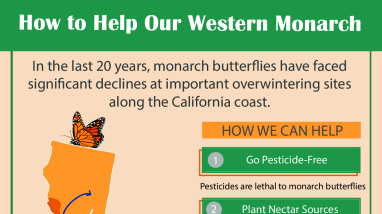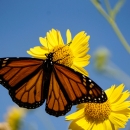Counties across the Central California Coast can lead the way by championing initiatives to support monarchs and you too can do your part. Local gardeners, landowners, and nurseries all play a key role to help monarchs thrive.
Here's how you can help:
- Plant native nectar plants such as California bush sunflower, yarrow, and coyote bush found at your local nursery. These flowering plants provide the nourishment and habitat monarchs need.
- If you live at least one mile from the coast, plant early season native milkweed (narrow leaf milkweed, California milkweed, or Indian milkweed). It is important to plant milkweeds that leaf out early in the season because monarchs are known to leave overwintering sites earlier due to climate change climate change
Climate change includes both global warming driven by human-induced emissions of greenhouse gases and the resulting large-scale shifts in weather patterns. Though there have been previous periods of climatic change, since the mid-20th century humans have had an unprecedented impact on Earth's climate system and caused change on a global scale.
Learn more about climate change . Try to plant pesticide free milkweed whenever possible. Avoid planting milkweed closer to the coast near monarch overwintering sites because it can interrupt their natural lifecycle and reduce migration. Milkweed did not historically occur on the coast. - Do not plant nonnative tropical milkweed because it can result in year-round breeding, increase parasites on monarchs, and the loss of monarch’s migratory behavior. Did you know that the State of California categorizes tropical milkweed as a pest of known environmental detriment? Ventura County has declared it a noxious weed, implementing a ban on the sale of tropic milkweed commercially.
- Use alternatives to pesticides, and particularly insecticides, because they are toxic to monarch butterflies and other pollinators.
- Be a monarch butterfly champion by educating others about how they can help.
Facility
Species
FWS Focus


